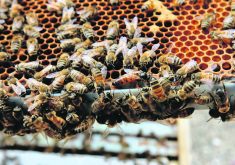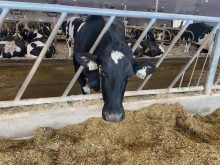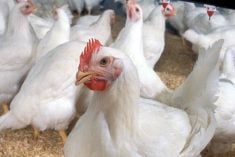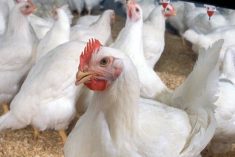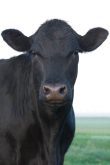A rise in antimicrobial resistance has prompted officials to start monitoring chicken operations in four provinces.
The Canadian Integrated Program for Antimicrobial Resistance Surveillance (CIPARS) will begin monitoring broiler chicken operations early this year, the Public Health Agency of Canada said in a statement.
The expanded surveillance project will gather data from farms in Ontario, Quebec, Alberta and B.C. over one production cycle.
“The project will be comprised of on-farm sampling, both at chick placement and prior to processing,” said Steve Leech, manager of food safety, animal care and research for the Chicken Farmers of Canada (CFC).
Read Also

Beekeepers want financial protection against tropi mite
What happens to beekeepers if the deadly tropi mite reaches Canada? Discover why farmers want robust compensation to protect pollination.
Environmental testing will also occur, and participating producers will be asked to fill out a questionnaire regarding antibiotic use, he said.
This is the first time there will be surveillance at the farm level, although CIPARS has monitored antimicrobial resistance in broilers at slaughter and retail. That monitoring showed a significant correlation between an antimicrobial-resistant strain of salmonella called serovar Heidelberg isolated from grocery store chicken and the incidence of the same strain of salmonella infections in people across Canada. The prevalence of antimicrobial resistance is higher in retail chicken, than retail pork or beef, says the Public Health Agency of Canada statement.
“For example, the prevalence of resistance among generic E. coli (Escherichia coli) isolated from retail chicken is significantly higher than from retail beef or pork samples; including to antimicrobials of very high or high importance to human health,” the agency said.
Leech said there is a need for better surveillance and alternatives to antibiotics.
“We’ve been working in collaboration with (CIPARS) for a number of years to develop a framework and policy on how the on-farm surveillance would be implemented,” said Leech, adding CFC funded a pilot project at the University of Guelph to test the surveillance system.
Currently there is little information on antibiotic use and the results of that use in broiler operations.
“This will provide us with a much better picture of resistance patterns at different points of the grow-out, as well as antibiotic use at those times,” he said.
The surveillance program will likely make its way into Manitoba in the near future, said Jake Wiebe, president of the Manitoba Chicken Producers.
“Manitoba has been a vocal province in looking for some solutions in this whole issue, and this is the first step in the process,” he said.
Not all provinces adhere to the same practices involving antibiotic use, he added.
“We’re trying to establish whether production practices are the same across the country, we believe they may not be,” said Wiebe.
Manitoba chicken farmers are also looking to mitigate the risks of antibiotic use, he said, adding there has been discussion on requiring veterinary prescription for antibiotics.
“These might be decisions we want to move away from the farm gate,” he said.


